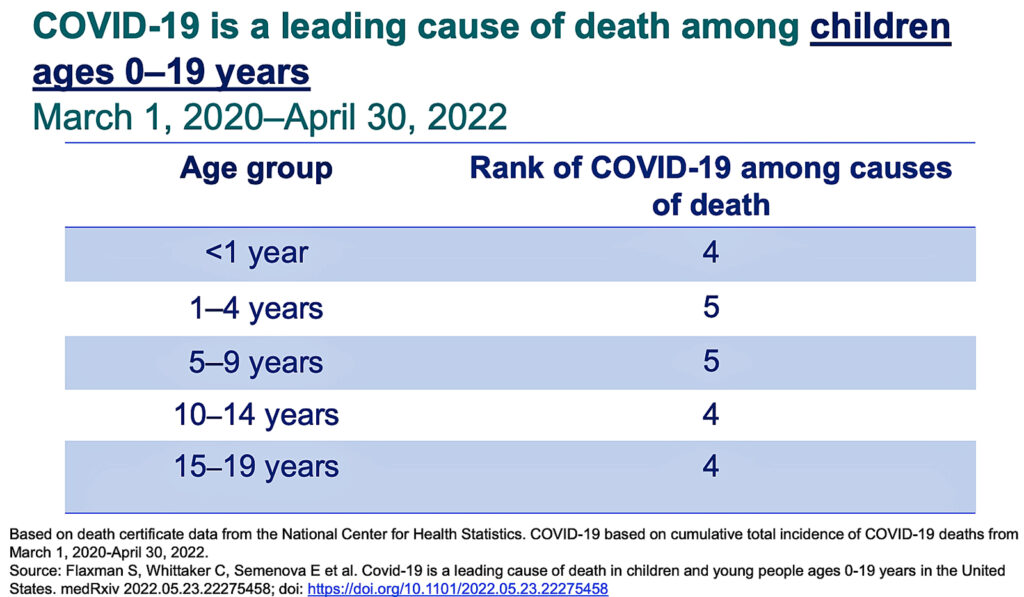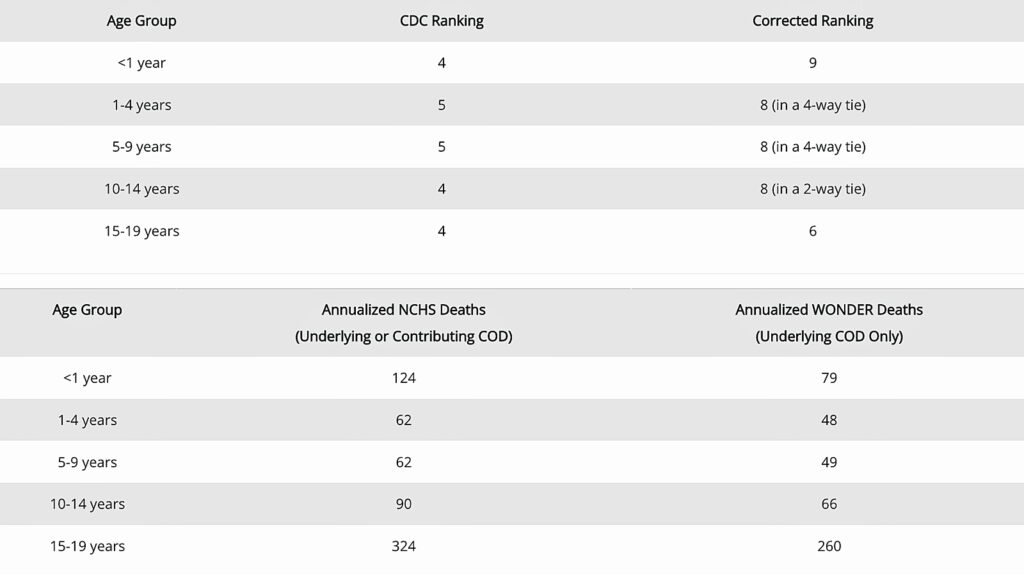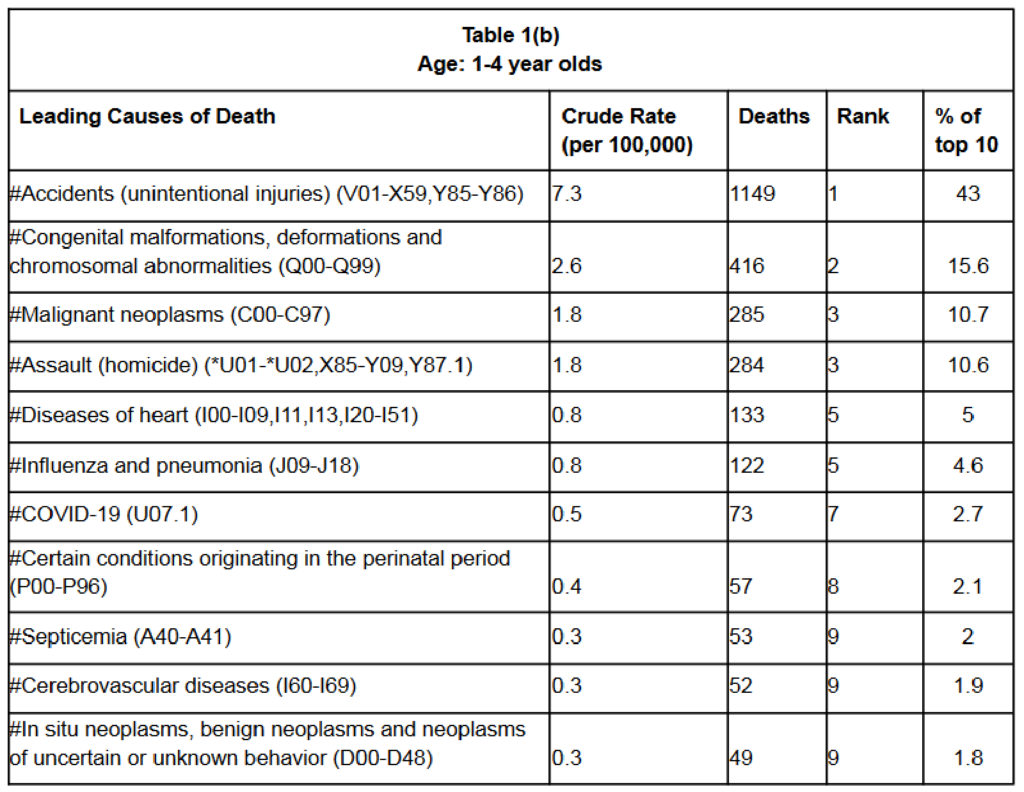CDC Official Used Flawed Data to Justify COVID Shots for Infants and Children, Analysis Shows
An official with the Centers for Disease Control and Prevention (CDC) used data from a flawed preprint study that exaggerated the risk of death for children from COVID-19 in her presentations to CDC and U.S. Food and Drug Administration advisors who were responsible for recommending Pfizer and Moderna’s vaccines for infants and young children.
Miss a day, miss a lot. Subscribe to The Defender's Top News of the Day. It's free.
An official with the Centers for Disease Control and Prevention (CDC) used data from a flawed preprint study that exaggerated the risk of death for children from COVID-19 in her presentations to CDC and U.S. Food and Drug Administration (FDA) advisors who were responsible for recommending Pfizer and Moderna’s vaccines for infants and young children.
The study, first published May 25 on the medRxiv preprint server, was authored by a group of U.K. researchers. On June 28, the authors published a revised version of the study, after critics questioned some of their original findings.
“It’s really disturbing that data this poor made its way into the meetings to discuss childhood COVID and that it took me less than a few minutes to find a major flaw (and then I found many more as I looked deeper),” said Kelley K, who was the first to point out some of the study’s flaws on her website COVID-Georgia.com.
After learning of Kelley’s analysis, The Defender reviewed the original preprint, confirmed Kelley’s findings and uncovered additional flaws in the original preprint and also in the June 28 revised version.
Study falsely claimed COVID was leading cause of death in U.S. children
During a June 17 meeting of its Advisory Committee on Immunization Practices to discuss pediatric COVID-19 vaccines in children under 5, Dr. Katherine Fleming-Dutra, a pediatrician and pediatric emergency medicine physician with the CDC, presented a table that falsely claimed COVID-19 was a leading cause of death in U.S. children.
Fleming-Dutra earlier that week presented the same table during the FDA’s vaccine advisory committee meeting, along with other slides from the original U.K. study that also falsely claimed COVID-19 as a “top 5 cause of death” in children.
The table, which was sourced from the U.K. study, was disseminated widely by physicians on Twitter who claimed the data “made the case” for vaccinating children under 5.

The table was part of a slide deck on the epidemiology of COVID-19 in children and adolescents, developed under the direction of Fleming-Dutra.
A disclaimer at the end of the slide deck states, “The findings and conclusions in this report are those of the authors and do not necessarily represent the official position of the Centers for Disease Control and Prevention.”
The table illustrated the study’s claim that COVID-19 caused more than 1 million deaths in the U.S, including at least 1,433 deaths among children and young people ages 0 to 19 years old from March 1, 2020, to April 30, 2022.
The study’s authors originally ranked COVID-19 ninth among all causes of death in children and adolescents ages 0 to 19, fifth in disease-related causes of death — excluding accidents, assault and suicide — and first in deaths caused by infectious/respiratory diseases.
The authors stated they “only consider COVID-19 as an underlying — and not contributing — cause of death.”
However, that statement is false — because the study in fact cited data from the National Center for Health Statistics (NCHS), which tabulates COVID-19 deaths by including any death certificate that mentions COVID-19, not just those cases where COVID-19 was the primary reason for death.
Using NCHS data, there were 1,433 pediatric COVID-19 deaths through April 30.
However, using the CDC’s own mortality statistics, which count only those deaths where the virus was the underlying cause, there were only 1,088 pediatric deaths — nearly 25% less than the NCHS and the study stated.
After the misleading data was brought to the attention of the authors, they revised the study to reduce the number of COVID-19 deaths among children and adolescents, from 1,433 deaths to 1,088 deaths — making COVID-19 the eighth leading cause of death in the 0 to 19 age group.
Cumulative versus annualized death rates — why it matters
According to Kelley K’s analysis, one key misleading aspect of the U.K. study was that it ranked cumulative COVID-19 deaths alongside annual rates for other causes of death.
Cumulative death rate refers to the proportion of a group that dies over a specified time interval. Annualized deaths are those that occur over the course of a year.
In ranking COVID-19 deaths by age group, the authors of the preprint included both cumulative (over 26 months) and annualized deaths, which inexplicably ranked COVID-19 twice for each age group, according to Kelley.
For instance, in the 1 to 4 age group, the paper listed cumulative COVID-19 deaths as the fifth leading cause of death.
The annualized COVID-19 deaths also appeared on the same list in their proper position.
For each age group, the cumulative COVID-19 death rate was more than double the annualized death rate.
Kelley recreated the results of the preprint using CDC WONDER, which utilizes “a rich ad-hoc query system for the analysis of public health data.”
Using that system, she obtained data where COVID-19 is listed as the underlying cause of death during the time period listed in the original study. She then annualized the results.
Kelley also showed the annualized number of deaths when using only those deaths where COVID-19 was listed as the underlying cause.

When the data is annualized and includes only those deaths where the virus was the underlying cause, COVID-19 does not rank as a leading cause of death for young children, the Daily Caller reported.
For kids under age 1, COVID-19 ranks ninth — behind influenza and pneumonia, heart disease and homicide. And accidents are almost 25 times more likely to kill an infant than COVID-19, according to the CDC WONDER data.
Among kids ages 1 to 4 and 5 to 9, COVID-19 ranked in a four-way tie for the eighth leading cause of death. For ages 10 to 14, it ranked in a two-way tie for eighth. For teenagers between 15 and 19 years old, it dropped from fourth to sixth.
Even using correct data, there are still issues with showing the impact of COVID-19 deaths in children using rankings, according to Kelley.
Kelley wrote:
“Rankings overstate the impact of COVID, because the top few causes of death far outweigh the causes further down the list. For example, in ages 1 to 4, accidents account for almost 25 times as many deaths as COVID-19 on an annualized basis.
“Furthermore, for each of the 4 age groups covered by the CDC slide, the very broad ‘accidents’ is the leading cause of death. If we break that down further, causes of death like drownings, vehicle crashes, and drug overdoses, would be individual causes of death greater than COVID in various age groups.”
Why did U.K. researchers use U.S. COVID death data?
Another issue with the preprint is the use of pre-pandemic data from 2019, instead of 2020 or 2021, to compare other causes of death with COVID-19.
According to the CDC website on “excess deaths associated with COVID-19,” the nation’s response to the pandemic may have altered mortality patterns.
The CDC states:
“The estimates of excess deaths reported here may not be due to COVID-19, either directly or indirectly the pandemic may have changed mortality patterns for other causes of death.
“Upward trends in other causes of death (e.g., suicide, drug overdose, heart disease) may contribute to excess deaths in some jurisdictions. Future analyses of cause-specific excess mortality may provide additional information about these patterns.”
In addition, U.K. researchers incorrectly analyzed U.S. deaths, by using NCHS data instead of CDC WONDER data, raising the question of why they didn’t use data in their own country, Kelley said.
“Could it be because the U.S. counts COVID deaths very generously, so our data made it easier to present COVID as a leading cause of death in children?” Kelley asked.
“In addition, why did they inflate the counts by including 18- and 19-year-olds in the data, when the pediatric population is generally accepted to be 0-17?”
Kelley wrote:
“On the CDC side, how did Dr. Katherine E. Fleming-Dutra, M.D. at the CDC — a pediatrician and doctor of emergency medicine — not realize this data was seriously flawed and out of line with all other data about the impact of Covid on pediatric mortality?
“How did a pre-print get used in an ACIP and FDA presentation with such little oversight without the quality of the data being fully vetted? How did I uncover these issues, instead of them being identified by someone whose job it is to evaluate this kind of data?”
“We are forced to believe that the CDC researchers who put this data together are either incompetent or liars when all the mistakes go in the same direction,” Kelley said.
“It certainly seems like the CDC uses whatever data they can find to push their agenda without any consideration to its veracity,” she said.
Researchers revise preprint but still use mismatched data
In a revised preprint released June 28, the study’s authors admitted they improperly calculated COVID-19 deaths and adjusted the rankings for each age group using CDC WONDER data.
However, the researchers utilized several tactics to exaggerate COVID deaths in children in their revised version of the study.
First, the authors reduced the study period from March 1, 2020 – April 30, 2022, to April 1, 2021 – March 31, 2022 — selecting the worst 12-month period of the pandemic.
The authors claimed that changing the date range “simplified” comparison time periods.
“We have fixed an error: our comparisons now use COVID-19 underlying cause of death data obtained from CDC Wonder. We have also simplified the comparison time periods,” the revised preprint states in a footnote.
Researchers then concluded, “COVID-19 mortality is a leading cause of death in CYP [children and young people] aged 0-19 years in the U.S.”
The authors of the study admitted in the revision that “deaths among U.S. CYP are rare in general” so they argued the mortality burden of COVID-19 in the younger age groups is “best understood in the context of all other causes of CYP death.”
The authors also altered the study, adding a “percentage of top 10 deaths” to the table for children ages 1 to 4, instead of noting where COVID-19 fits as a percentage of all-cause deaths.
COVID-19 appears as the seventh leading cause of death in children ages 1 to 4, however, it comprises only 2.7% of total deaths. To put that into perspective, the six more frequent causes add up to 89.5%.
The COVID-19 deaths were then compared to deaths from a different time period.
 Kelley tweeted:
Kelley tweeted:
Dr. Susan Bewley, an obstetrician and BMJ award-winner, did a side-by-side comparison of the two preprints and concluded there should be a “major retraction” or “corrected post-publication” as the preprint was significantly altered.
CDC and FDA fail to acknowledge misleading data
The Daily Caller reached out to the CDC about its misleading data and asked how the study made it through the agency’s “rigorous review process.”
The CDC did not respond to multiple requests.
The Defender also contacted the CDC for comment on the preprint used as the basis for authorizing COVID-19 vaccines for emergency use in children. We were directed to call the CDC’s media relations department, but the number listed and provided by the CDC and its automated system is no longer a working number.
The Daily Caller also made multiple attempts to contact the FDA.
The FDA said:
“FDA speakers in the June 14-15th meeting of the Vaccines and Related Biological Products Advisory Committee (VRBPAC) did not cite the study in question in their presentations. FDA’s press release announcing the authorizations explains the basis for our determinations.”
But as the Daily Caller reported, and slides from the meeting show, that’s not entirely true.
Although the FDA itself did not present the paper during the meeting, the paper was presented by Fleming-Dutra who claimed COVID-19 was a leading cause of death among children and adolescents 1 to 19 years of age and cited the erroneous preprint and NCHS statistics as the source of the data.
That slide and others claiming COVID-19 was a leading cause of death among children helped form the basis of the panel’s decision to recommend expanding the Emergency Use Authorization of Pfizer and Moderna’s COVID-19 vaccines to infants and toddlers.
The Daily Caller reached out to all 11 authors listed as contributors to the research. Only Dr. Deepti Gurdasani, an epidemiologist and senior lecturer at Queen Mary University of London responded.
Gurdasani wouldn’t comment on the effect of publishing flawed research affecting the healthcare of millions of children other than to chastise Fox host and Daily Caller co-founder, Tucker Carlson.
Another author of the study, Seth Flaxman, with the U.K’s University of Oxford, tweeted after the flaws in the paper were exposed that his team was working on a revised version of the study.
To date, neither the CDC nor FDA have publically issued a comment or correction on the flawed study cited by the CDC during vaccine advisory meetings to determine whether COVID-19 vaccines should be authorized for infants and small children.
The study has not been retracted.

